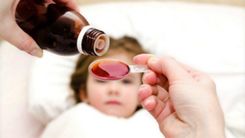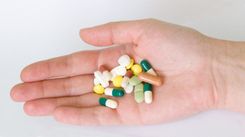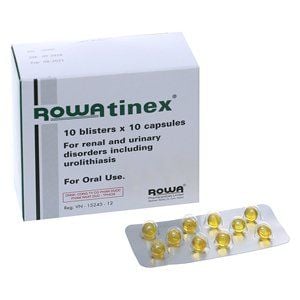To treat symptoms related to degenerative joint diseases, Diacerein is the top choice. This medication has a slow-acting effect and is used as a long-term treatment method. To ensure effective treatment and avoid side effects, patients should use the medication as prescribed or consult with a doctor or pharmacist.
1. What is Diacerein 50 mg?
Diacerein belongs to the group of non-steroidal anti-inflammatory drugs (NSAIDs) used to reduce pain and swelling associated with osteoarthritis. The medication is formulated as hard capsules with a dosage of 50 mg.
2. Uses of Diacerein 50 mg
2.1. Pharmacodynamics
Diacerein is often prescribed in degenerative joint diseases due to its anti-inflammatory effects, as it does not inhibit the synthesis of Prostaglandins and is well tolerated by the stomach.
The mechanism of Diacerein is that it affects both the anabolic and catabolic processes of cartilage cells and reduces pro-inflammatory factors. Results from several in-vivo studies show that Diacerein and Rhein, an active metabolite, inhibit the production and activity of the pro-catabolic and pro-inflammatory cytokine IL-1b in both the superficial and deep layers of cartilage, and even in the synovial membrane. Additionally, it stimulates the production of transforming growth factor (TGF-b) and extracellular matrix components such as aggrecan, proteoglycan, hyaluronic acid, and type II collagen. Furthermore, Diacerein has shown to inhibit macrophage migration and phagocytosis. Studies in animals with osteoarthritis have shown that Diacerein reduces cartilage degradation compared to untreated groups. Clinical studies have shown significant pain reduction and improved joint function compared to those taking a placebo after one month of treatment with Diacerein.
Many studies have reported that the beneficial effects of Diacerein treatment persist for at least two months after discontinuation of the drug.
2.2. Pharmacokinetics
With a dosage of 50 mg taken twice daily, Diacerein passes through the liver before entering the systemic circulation and is fully deacetylated to rhein (an anthraquinone metabolite of rhein anthrone and senna glycoside, which has hepatoprotective effects). This substance undergoes sulpho conjugation, with approximately 20% of rhein being excreted through the kidneys or conjugated in the liver to form rhein sulfate (20%) and rhein glucuronide (60%), which are primarily excreted through the kidneys. When Diacerein is administered in doses ranging from 50 mg to 200 mg as a single dose, all pharmacokinetic parameters are dose-independent. The protein binding is very high (99%), mainly due to strong binding affinity with albumin. The half-life of rhein is approximately 4.5 hours, with peak plasma concentrations occurring around 2.5 hours.
Taking Diacerein with meals increases its bioavailability. The total amount of the drug excreted in the urine is about 30%. Approximately 80% of rhein is excreted in the urine as sulpho and glucuro conjugates, and about 20% as unchanged rhein. After repeated dosing (50 mg twice daily), Diacerein shows slight accumulation.
The effects of Diacerein are similar in young, healthy individuals selected for trials and older individuals with normal renal function when given a single dose (50 mg) or repeated doses (25 or 75 mg twice daily). Steady-state concentrations are achieved after the third daily dose, with an average half-life of 7 to 8 hours.
In patients with severe renal impairment (creatinine clearance below 30 ml/min), the area under the curve (AUC) and half-life are doubled, and urinary excretion is halved.
Taking Diacerein with a main meal hinders its absorption into the systemic circulation but increases the amount absorbed by 25%.
2.3. Contraindications of Diacerein 50 mg
Diacerein should not be used in patients who are hypersensitive to the drug, its excipients, or those with a history of hypersensitivity to anthraquinone derivatives.
2.4. Side Effects of Diacerein 50 mg
The most common side effects during treatment with Diacerein are increased bowel transit time and abdominal pain. These symptoms may appear within the first few days of treatment and usually subside with continued use. Additionally, patients may experience:
- Diarrhea
- Stomach pain, abdominal pain, bloating
- Nausea, vomiting
- Hepatitis
- Jaundice
- Elevated liver enzymes
- Allergic skin reactions such as itching, rash, eczema
Using Diacerein can sometimes cause dark yellow urine. This is a typical sign of the compounds in the drug and has no clinical significance. Inform your doctor of any unwanted side effects experienced while using the medication beyond those listed above.
2.5. Interactions with Other Medications
Medications that may interact with Diacerein include:
Aluminum hydroxide, magnesium hydroxide, or calcium-based antacids.
Antibiotics (e.g., amoxicillin/clavulanic acid) and/or chemotherapy due to the increased risk of gastrointestinal events.
Increased risk of dehydration and hypokalemia when used with diuretics.
Concurrent use with cardiac glycosides such as digitoxin or digoxin increases the risk of arrhythmias.
If these substances need to be taken, they should be administered at a different time (more than 2 hours apart) after taking Diacerein.
2.3. Contraindications of the drug Diacerein 50 mg Diacerein should not be used in patients who are hypersensitive to the drug, its excipients or who have a history of hypersensitivity to anthraquinone derivatives.
2.4. Diacerein 50 mg side effects Rapid increase in intestinal transit time and abdominal pain are the most common side effects during treatment with Diacerein. These symptoms may appear within the first few days of treatment and in most cases, however, they resolve on their own with continued treatment. In addition, patients also experience some symptoms such as:
Diarrhea Stomach pain, abdominal pain, bloating Nausea, vomiting Hepatitis Hepatitis Yellowing of the skin and eyes Increased levels of liver enzymes Allergic skin reactions such as itching, rash, eczema Taking Diacerein can sometimes make urine darker yellow. This is typical of the type of compound present in the drug and is of no clinical significance. Inform your doctor about any unwanted effects encountered when using the drug other than the above effects.
2.5. Interactions with other drugs Drugs that may interact with Diacerein include:
Aluminum hydroxide, magnesium hydroxide or calcium-based antacids. Antibiotics (eg, amoxicillin/clavulanic acid) and/or chemotherapy because of the potential for increased risk of intestinal events. Increased risk of dehydration and hypokalemia when used with diuretics. Concomitant use with cardiac glycosides such as digitoxin or digoxin increases the risk of cardiac arrhythmias. If these substances are needed, they should be taken at a different time (more than 2 hours) after taking Diacerein.
3. How to use Diacerein 50 mg
Take the medication with filtered water along with meals:
3.1. Dosage and Administration
The dosage and duration of medication use for each patient should be as prescribed by the treating physician.
Usual dosage: 1 capsule per dose, twice a day after the two main meals, for a period as directed by the doctor. Diacerein may increase bowel transit time during the first two weeks of treatment. Therefore, patients should start with 1 capsule per day, taken after dinner, for the first two weeks, and then the dosage can be increased to 2 capsules per day.
Beneficial changes can be observed after 2 to 4 weeks of treatment, so patients should be encouraged to continue treatment until the medication's effects become clear. It may be combined with a pain reliever or non-steroidal anti-inflammatory drug (NSAID) during the first 2 to 4 weeks of treatment, as Diacerein has a slow onset of action and is well tolerated by the gastrointestinal tract.
4. Precautions When Using Diacerein 50 mg
Currently, there are no clinical studies on children under 15 years old. Therefore, Diacerein should not be prescribed for children in this age group.
Diacerein should not be used concurrently with laxatives, as it may cause acute diarrhea.
Do not use Diacerein for pregnant women.
Additionally, Diacerein should not be prescribed for breastfeeding women, as reports have indicated that small amounts of Diacerein derivatives can pass into breast milk. Regular monitoring, blood tests, liver function tests, and urine tests are necessary while using this medication. Patients with a history of liver disease, kidney disease, or previous bowel disorders (e.g., irritable bowel syndrome) should inform their doctor before using the medication.
Diacerein belongs to the group of non-steroidal anti-inflammatory drugs (NSAIDs) used to reduce pain and swelling associated with osteoarthritis. To ensure effective treatment and avoid side effects, patients should use the medication as prescribed or consult with a doctor or pharmacist.
To arrange an appointment, please call … or make your reservation directly HERE. You may also download the MyVinmec app to schedule appointments faster and manage your reservations more conveniently.













